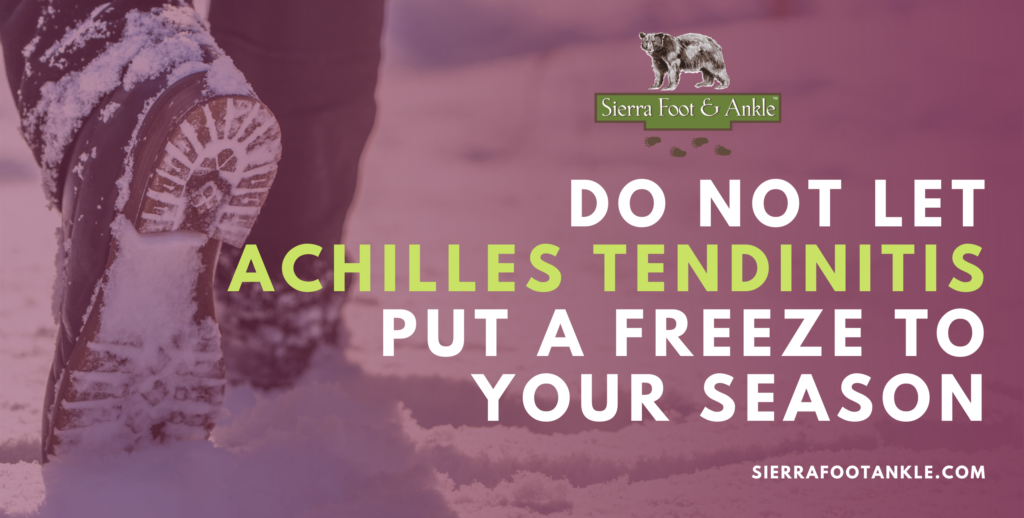Do Not Let Achilles Tendinitis Put a Freeze to Your Season
If you are a runner or other outdoor enthusiast around here, you must admit we’re pretty lucky compared to other places.
Things can get cold, certainly, but we rarely get plunged into a deep enough freeze to put a major halt to routines. If you’re able to add some layers, you can get out there comfortably on most days.
That said, a colder shift can lead to changes and shortcuts in routines. And sometimes, those choices can increase your risk of a sustaining a sports injury, like Achilles tendinitis. That sort of hit can really put your workout plans on ice for a while!
No matter the season, it’s always wise to review ways you can prevent Achilles tendinitis and other problems from developing. We always want our patients to get back to action as quickly and safely as possible after a sports injury, and the best means of treatment is keeping the problem from happening in the first place!
So, the next time you plan on getting out and being active, keep the following in mind.
The Key Word is…
Overuse.
Achilles tendinitis, and many of the other types of injuries athletes face, are classified as overuse injuries.
What this means is that the injury occurred because the body was pushed harder or farther than it was conditioned to endure. This is opposed to an injury that happens from a sudden force or impact, like slipping on a patch of ice or getting hit by a snowplow.
You can’t always avoid sports injuries, but the good news is that the risk of overuse injuries can be significantly reduced by making smart choices!
Take Time to Warm Up and Cool Down
Taking off at full speed from a cold standstill is one way to over-strain your system. One way you can help yourself out is by not neglecting warm-ups and cool-downs.
Take a few minutes to stretch muscles and lightly move about. If your Achilles is a concern, you will want to do stretches that focus on your heel and calf muscles. These are the two places your Achilles connects to and stretching in this area helps your tendon prepare to move.
(In fact, stretches for your calf muscles are a great idea on a daily basis, as tight, unconditioned calf muscles can place extra stress on your Achilles.)
When the weather is colder, the temptation is to get moving as quickly as possible to not allow the chill to settle in. But instead of doing that, why not perform your warm-ups indoors instead? Do some stretches on the stairs. Jog in place in front of the TV. Pull some yoga poses on the bed!
Warming up before you head out into the cold will help you stay warmer from the start, and put your layers on after you warm-up so you don’t begin an outdoor workout with dampness against your skin.
And after your workout, don’t forget to cool down to transition your muscles and soft tissues back to a resting state more comfortably. You can also do this in the house, if you’d like.
Be Smart About Your Footwear
The shoes you use for your activity should always be designed with the stresses for that activity in mind.
Your shoes should provide the proper amount of cushioning for your heels and firm support for your arches. Both of these elements will help reduce stress against your Achilles tendon.
If you engage in sports with quick pivots or side-to-side movements (such as basketball or tennis), use shoes that provide support for these motions as well. It doesn’t matter whether you play indoors or outdoors!
And yes, all of this means you should never go out running in boots or shoes that aren’t right for your needs! If you want a pair of running shoes that are best for keeping out cold and moisture, a trained associate at your local sporting goods store should be able to help.
Cross-Train and Give Yourself a Rest
No matter what other precautions you take, you are aiming for an injury if you keep pushing your body too hard without giving it a chance to rest.
Rest is not a wasted day in a workout plan. In fact, it is essential for allowing your body to recover from the physical stress you place on it, so that it can come back stronger. If you don’t give your body the chance to do this, you just keep applying strain to an increasingly damaged and weakened body—and eventually something breaks.
You should plan rest days into your weekly workouts no matter the time of year. Additionally, reserve some days to focus on other parts of your body. Swimming and cycling are great activities that have low impact on your feet and ankles while providing a great aerobic and strength workout.
If you are wondering what the best exercises to cross-train in would be for your particular needs and situation, please don’t hesitate to reach out to us about it!
Keep Your Achilles (and the Rest of You) Well Year-Round
Reducing your sports injury risk is smart but ignoring a problem you are already experiencing is not.
If you have been enduring persistent pain in your heels, ankles, or feet, do not wait any longer. Schedule an appointment with us and we’ll help you get to the root of the problem! We understand the needs of athletes—from weekend warriors to dedicated goal-setters—and we will recommend the best treatment plan to match your needs.
Call our Carson City office at (775) 783-8037 to schedule an appointment, or fill out our online contact form if you prefer to reach us electronically.
© Sierra Foot & Ankle. All Rights Reserved. Privacy Policy.
Web Design by CP Solutions. Marketed by VMD Services.

